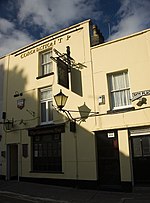Cornwallis Crescent, Bristol

Cornwallis Crescent is a late 18th-century crescent of 24 Georgian town houses, located between York Gardens and Cornwallis Avenue in the Clifton area of Bristol. The postcode is within the Hotwells and Harbourside ward and electoral division, which is in the constituency of Bristol West.The crescent, with private communal gardens, is located within the Clifton conservation area, The area has Grade II buildings and has mid Georgian style which are constructed in brick with a limestone ashlar front and the rear of render over brick with limestone dressings. It has a slate mansard half-hipped roof. Each three-storey house has an attic and basement which has a double-depth plan.
Excerpt from the Wikipedia article Cornwallis Crescent, Bristol (License: CC BY-SA 3.0, Authors, Images).Cornwallis Crescent, Bristol
Zig-Zag, Bristol Hotwells
Geographical coordinates (GPS) Address Nearby Places Show on map
Geographical coordinates (GPS)
| Latitude | Longitude |
|---|---|
| N 51.4542 ° | E -2.6265 ° |
Address
Zig-Zag
BS8 4BD Bristol, Hotwells
England, United Kingdom
Open on Google Maps







